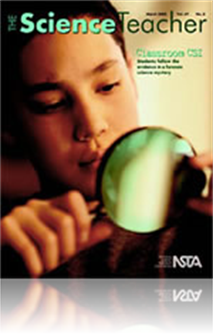All Resources
Journal Article
Who Killed Myra Mains? Students investigate a mock crime scene in an integrated science unit
Students become crime scene investigators as they investigate a mock crime scene in an integrated science unit. In this inquiry-based lab, students must formulate and revise scientific explanations, as well as communicate and defend a scientific argu...
Journal Article
Outstanding Science Trade Books for Students K-12 (Books Published in 2001)
The Outstanding Science Trade Books for Students K–12 is a listing of the best books published in 2001. The selection is made by the National Science Teachers Association/Children’s Book Council Joint Book Review Panel. ...
Journal Article
It's Time for Adventure Buddies
The authors describe a partnership among preservice teachers, education students, and classroom teachers in an inquiry-based program that introduces young children to physics by playing on a playground....
Journal Article
Outstanding Science Trade Books for Students K–12 (Books published in 2001)
The books that appear in this annotated bibliography were selected as outstanding science trade books published in 2001. They are intended primarily for kindergarten through twelfth grade. They were selected by members of a book review panel appointe...
Journal Article
This article describes a novel approach to evaluating students in a seminar-style science course. The approach involves students in the design of the assessment instrument and a defense of their own performance using the instrument, taking student pe...
Journal Article
Studying the brain and neurological disorders can enhance understanding, awareness, and tolerance in the classroom. Many popular movies that feature characters dealing with nuerological conditions like Alzheimer's disease, amnesia, brain injury, or m...
Journal Article
The Case Study: Science, Law, and the Pursuit of Knowledge
Science and law are institutions for developing, testing, justifying, and authorizing belief, yet are often viewed as two different ways of knowing. Although science and law both claim to be based on “facts,” their facts are disclosed in differen...
Journal Article
Creative Concept Mapping: A potato stamp encourages a positive attitude toward concept mapping
Concept mapping creates a “map” of students’ understanding of an idea or event and helps them understand concepts and their relationship with other ideas. This activity challenges students to create and design a concept map with potato stamps, ...
Journal Article
A current events journal keeps students involved with the latest scientific news and helps develop their writing and analytical skills. Every week, students select a science article, summarize the article in their journals, and define new vocabulary....
Journal Article
Current science can be made more relevant to students with teacher-guided discussions of science articles students have clipped from newspapers and magazines. This activity encourages active involvement with the material as students discover topics a...
Journal Article
Cartoon and Bumper Sticker Science
Humor is one of the most profound and subtle tools used in influencing people’s attitudes. It is also an efficient and pleasant way to communicate information. Humor can be found in every type of media, including movies, plays, books, photographs, ...
Journal Article
In this age of tabloid news and easy Internet access, students must be savvy information consumers. They need to be aware that not all the reports they see may be accurate or factual. It is, therefore, essential that students learn ways of analyzing ...
Journal Article
The preservice years are critical in professional teacher development. While a survey reveals that many preservice teachers are insecure about their abilities to teach science, they do view science as an important part of elementary education....
Journal Article
Malformed anurans (frogs and toads) are excellent bio-indicators—living organisms sensitive to environmental changes that are used to judge the quality of a certain habitat. Students investigate these phenomena online and start to understand the im...
Journal Article
Science Fiction and Science Education
Using science fiction films in the classroom can expose students to a wide variety of science topics. The films are particularly good for identifying student misconceptions, many of which are a product of these very films. A sample lesson using the m...
Journal Article
Names and Claims: Is it Science or Spin?
Students learn to be critical consumers of the media by analyzing “scientific” claims made by advertisers in commercials and print ads. After discussing advertising techniques and the concept of bias, students research consumer products and desig...
Journal Article
Science and Children’s editor shares thoughts regarding the current issue....
Journal Article
Interdisciplinary teaching, research experience, and active, collaborative strategies have all been identified as practices highly favorable to the learning process. By using the university campus as the focus for the study of the entire watershed wi...
Journal Article
Current Events and Technology: Video and Audio on the Internet
Teachers can utilize the vast audio and visual resources available on the Internet to bring current science events into the classroom. A wide variety of news sites as well as technology requirements and teaching suggestions are described....
Journal Article
An opinion piece about how our ability to use the scientific process in and out of school affects our ability to recognize wrong answers and question poor reasoning....
Journal Article
Evaluating College Science and Mathematics Instruction
This paper reports evaluative data on five courses that have taken part in a curriculum reform effort called the Arizona Collaborative for Excellence in the Preparation of Teachers. Primarily through summer faculty workshops, teaching reforms advocat...
Journal Article
Due to other professional commitments, teachers sometimes find it difficult to keep up with the latest developments in science and technology. Through the university Research Experience for Teachers (RET) programs, teachers have the opportunity to do...
Journal Article
Bridging Science and Engineering
The Colleges of Engineering and Education at Penn State University have collaborated to design and deliver an engineering course for education and other nonscience majors. In this course, students integrate basic principles of applied physical scienc...







